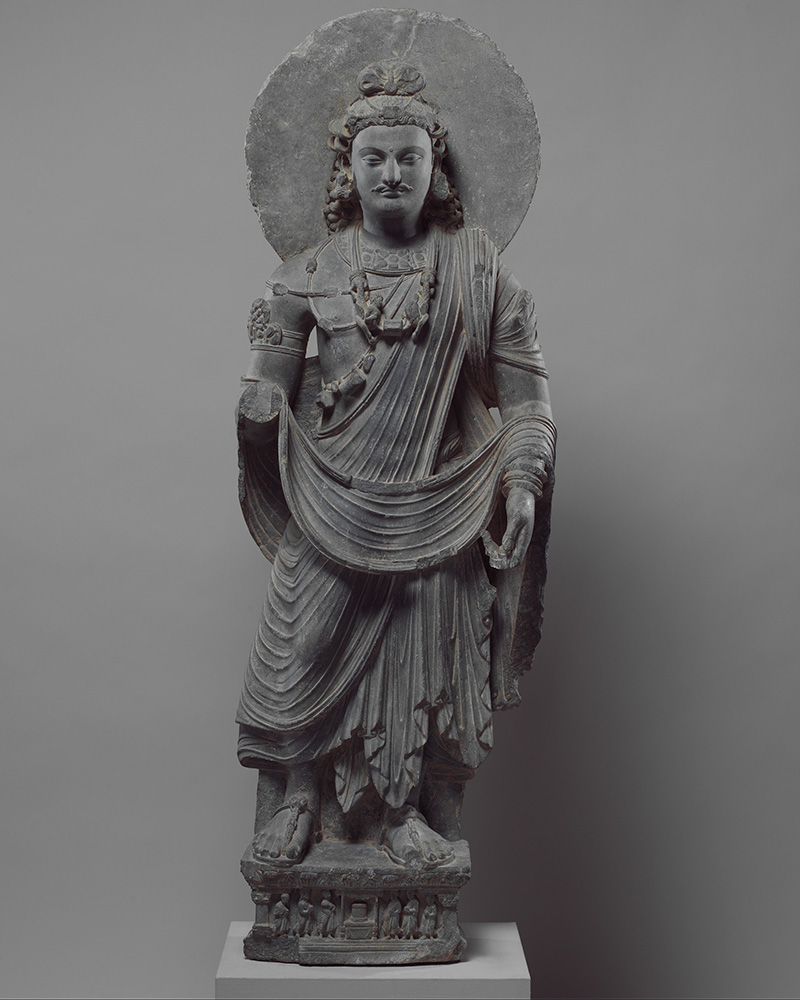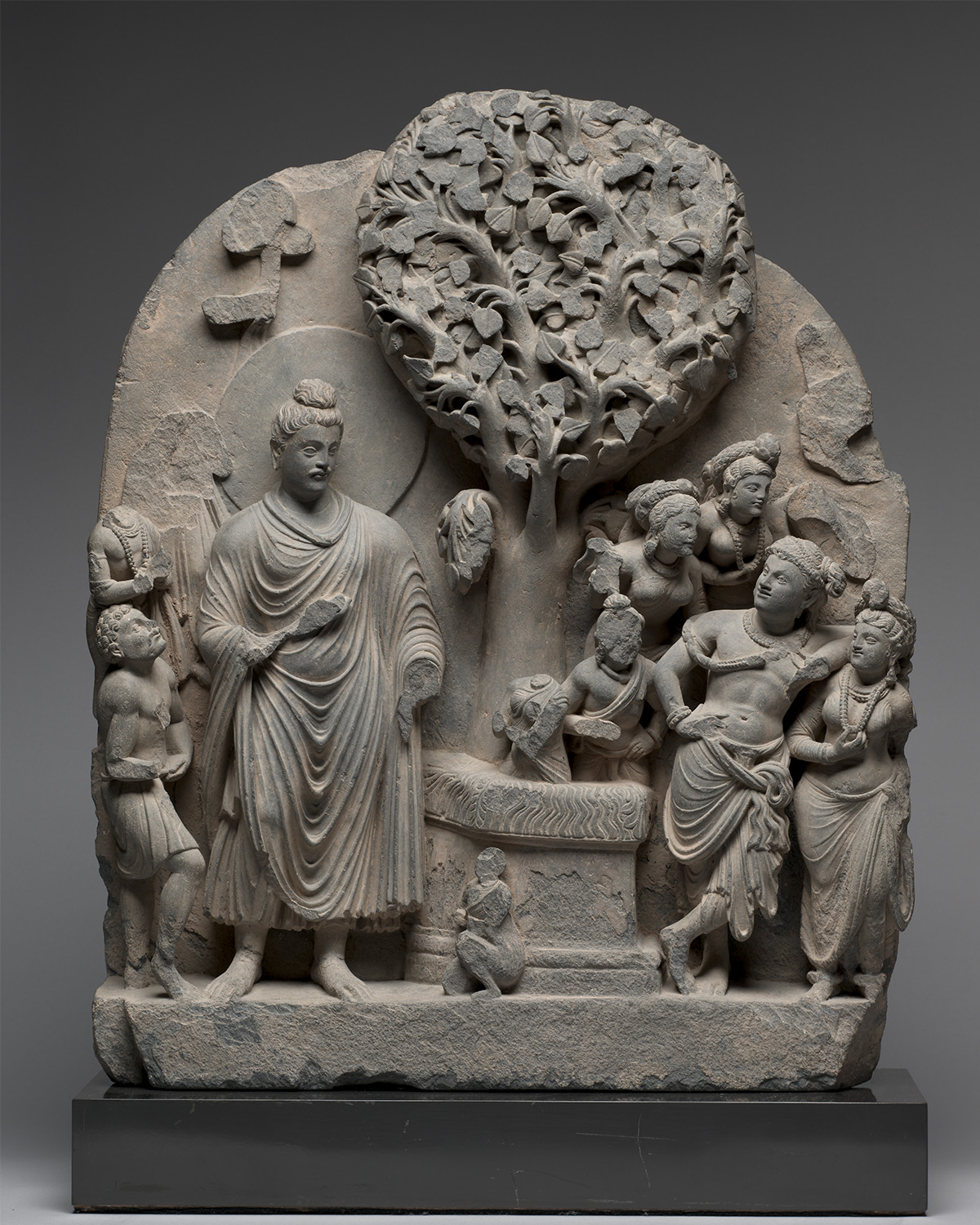ARTICLE
Gandharan Sculpture
The introduction of the anthropomorphised Buddha paved the way for narrative reliefs depicting his life, replete with iconography borrowed from Graeco-Roman and subcontinental cultures. These reliefs, usually depicting episodes from the Buddha’s last life, lined the dome and the base of stupas, and were read in ritual processions (pradakshina) clockwise around the stupa. For stupas of a large size, this narrative was supplemented by further tales from the Buddha’s past lives. The Buddha in this format is typically depicted as he is in statues: bearing a halo and no ornaments, wearing a long rippling robe, and having a calm countenance. The women that appeared in the narrative scenes are modelled after yakshis but are shown holding cornucopias and wearing wreaths and robes very similar to the classical Greek style. Their depiction under trees and leafy canopies prefigures the salabhanjikas or “maidens of the sal trees,” a popular image in later reliefs and sculptures. In this phase of relief art, one finds a close reference to textual sources such as the Abhiniskramana sutra, indicating Gandhara’s closer affinity to the Central Asian and Chinese textual traditions than the north Indian oral traditions.
After the second century, the narrative element was discarded in favour of portraiture in reliefs and friezes, mainly of the figures of the Buddha and bodhisattvas. These were decidedly devotional images, and exhibited a clear hierarchy of scale — the Buddha was shown as a looming figure, surrounded by diminutive secondary figures. Solo reliefs such as these were positioned above entrances to the stupa, and along the upper part of the drum, signifying to devotees the sanctity of the monument. The most common subject among these depictions was the seated Buddha in his moment of enlightenment under the Bodhi tree, which led early scholars to conclude that such images were part of a narrative series of the Buddha’s miracles. Friezes that did not feature the Buddha but showed lesser subjects, such as bodhisattvas and characters from the Buddha’s life, were used as stair risers, i.e., the vertical face of the stairs leading up along the stupa.
These stair-risers occasionally included non-Buddhist mythological figures carved in an emphatically Hellenistic style, either as an homage to the Indo-Greek culture or as a surviving remnant of it. These few but interesting examples include a series of spear-wielding Greek deities flanked by Corinthian columns, lines of inebriated figures courting a man who appears to be the Greek god Dionysius, images of Hercules carrying a vajra (a weapon representing a diamond and a thunderbolt), and the figure of the Atlas situated around the base of the stupa, symbolically holding it up. Another sculptural element rendered in this style, possibly from the early first century, was a ring of garland-holders: a procession of male and female figures arranged around the surface of the stupa’s drum, carrying heavy garlands over their shoulders. Inscriptions suggest that donors sponsored figurines such as these, as well as large reliefs and free-standing sculptures. Aside from stupa reliefs, free-standing statues and busts of Greek deities such as Athena and Poseidon were also made at Gandhara, although in very small numbers and with unknown patronage. Unlike the publicly visible emphasis on Buddhism, many finely made objects of personal use, such as combs and vases, almost exclusively featured Greek imagery. In particular, stone palettes (also known as toilet trays) which were used for mixing cosmetic pastes and powders, feature relief images of Greek gods, sea monsters and Nereids. These are unique to Gandhara, and were made between the second century BCE and the first century CE.
Gandharan sculpture can be broadly classified— based on the predominant medium used — into schist and stucco phases. Up until the third century CE, the stone used was almost exclusively grey, and occasionally green, schist. Stucco began to be used subsequently for reliefs as well as monumental free-standing statues of the Buddha and bodhisattvas because it lent itself better to modelling and was a more economical medium. These were made with an armature of wood, rope and straw — and sometimes even a rough core of schist — which was then covered and modelled in stucco. Gaining popularity as Gupta influence began to affect the style at Gandhara in the fifth century, stucco effected a slimmer, smoother silhouette that was more rounded in the shoulders than stone. Metal and ivory were reserved for devotional objects such as reliquaries and life-sized bronze Buddhas and bodhisattvas, and secular objects such as coins, mirror handles and combs. When the use of bronze for statuary grew more common, stylistic variations began to emerge, such as the expansion of the halo to envelop the standing Buddha figure.
Although Gandharan art is defined by its repertoire of Buddhist sculptures, it also includes a small but important body of Brahmanical representations. Most noteworthy and prevalent among them are the relief sculptures of Skanda, shown here as a martial hero before he was absorbed into the Hindu pantheon. Depicted in a suit of armour with a bow strung across the chest and a sword in hand, Skanda is shown trampling a similarly clad figure with a buffalo head. This representation of the Mahisasuramardini narrative as carried out by Skanda and not Durga, and is the only known depiction of a variant of the popular myth.
The extant and preserved Gandharan art, mostly from early acquisition during the British Raj, which received a great deal of attention for its notably hybrid nature has been dispersed across various institutions globally, with the largest collection being housed by the Metropolitan Museum of Art in New York. Other notable museum collections include the Karachi and Lahore Museums, the National Museum in New Delhi, the Indian Museum in Kolkata and the British Museum in London.
Bibliography
Our website is currently undergoing maintenance and re-design, due to which we have had to take down some of our bibliographies. While these will be re-published shortly, you can request references for specific articles by writing to hellomapacademy@map-india.org.









